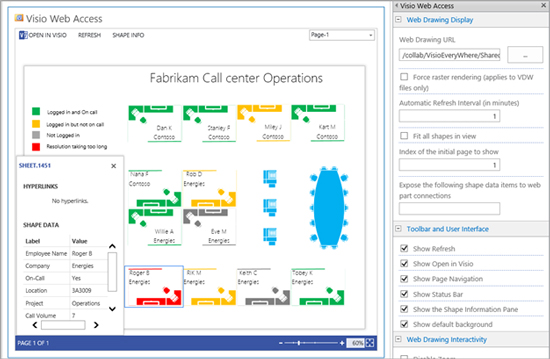Creating contextual dashboards in Visio
Ankit Tomar is a Program Manager on the Microsoft Visio team.
Dashboards are important business tools that provides real-time graphical representation of Key Performance Indicators (KPI) for business processes. Each dashboard conveys current status in a graphical manner, which helps surface problems and aids quick decision-making.
Usually a dashboard is presented as a collection of metrics with color coding that conveys whether the KPIs are being met. The metrics can be more meaningful and decision-making can be easier if data is visually represented to show it within the context of the business process.
A customer call center is an example of a business process that requires quick decision-making based on multiple metrics. A conventional call center dashboard will typically present the KPIs as follows:

A conventional dashboard showing metrics.
While this representation tells how the metrics are measuring up, it doesn’t give enough context and information about the source of the problem and the next steps required to fix possible issues. Compare this with the following dashboard created using Visio:

A contextual dashboard in Visio showing information on top of a floor plan.
This dashboard is created by layering the KPIs over the call center’s floor plan. It displays exactly where all employees are sitting, employee presence information, and call status. It is not only easy to recognize if there is an issue that needs attention, but also to see additional information on where the issue is.
For example, a quick look at the dashboard shows that Roger, who is handling calls for Energies, needs help. Clicking his “cubicle” reveals his physical location and other call-specific details, such as current call time. Based on this information, the call center manager can quickly make a decision about resolving the issue.

Example call center dashboard.
Here are the 5 steps to convert any schematic into a contextual dashboard:

In this call center example, we started with the following floor plan:

Example call center floor plan.
Note: If you don’t have a floor plan in a Visio file format, you can easily import other formats like AutoCad files (.dwg, .dxf) into Visio. You can also create a floor plan using built-in Visio stencils on the Maps and Floor Plans tab. We created the above floor plan using the Cubicles, Office Furniture and Walls, Doors and Windows stencils.
Converting the diagram into a dashboard using Visio Services
You can connect to a data source, link shapes to data and apply data graphics in a Visio organization chart, and you can also convert that data-linked diagram into a dashboard.
Visio Services allows you to set a data-linked diagram to refresh at a periodic interval and share it broadly with others who may not have Visio installed.
To convert our call center diagram into a dashboard, upload the diagram file to the same SharePoint server where the data source is located. Create a web page, then insert a web part. To do this, click Insert, then click Web Part, under the Business Data tab, click Visio Web Access. Now open the tools pane for the web part and configure it to display your diagram by browsing to it and placing its URL in Web Drawing URL. You can also configure other things, such as refresh interval, interaction behavior, and information you want to show.

Dashboard on SharePoint.
The dashboard is now ready to be shared with others to help improve efficiency in the context you choose.
–Ankit Tomar, Program Manager
